Visual acuity of eagles to site targets at great distances far exceeds any capability possessed by man. However, one select group of homo sapiens demonstrates an extraordinary ability to utilize their peripheral vision. That subset would, of course, be Car Guys.
Car Guys possess the ability to be weaving through a chaos of bouncing steel scrap unleashed from the back of a poorly stacked semi while still checking out from the corner of their eye the contents of an old barn behind a rickety farmhouse in a distant field.
Locating a barn find resides on a pedestal in the pantheon of Car Guy dreams. However, for one Car Guy in search of storage in garage starved New Jersey, his sharp eye caught site of a barn that would soon house his collection.
Meet Carl Grady.
When the find is the barn
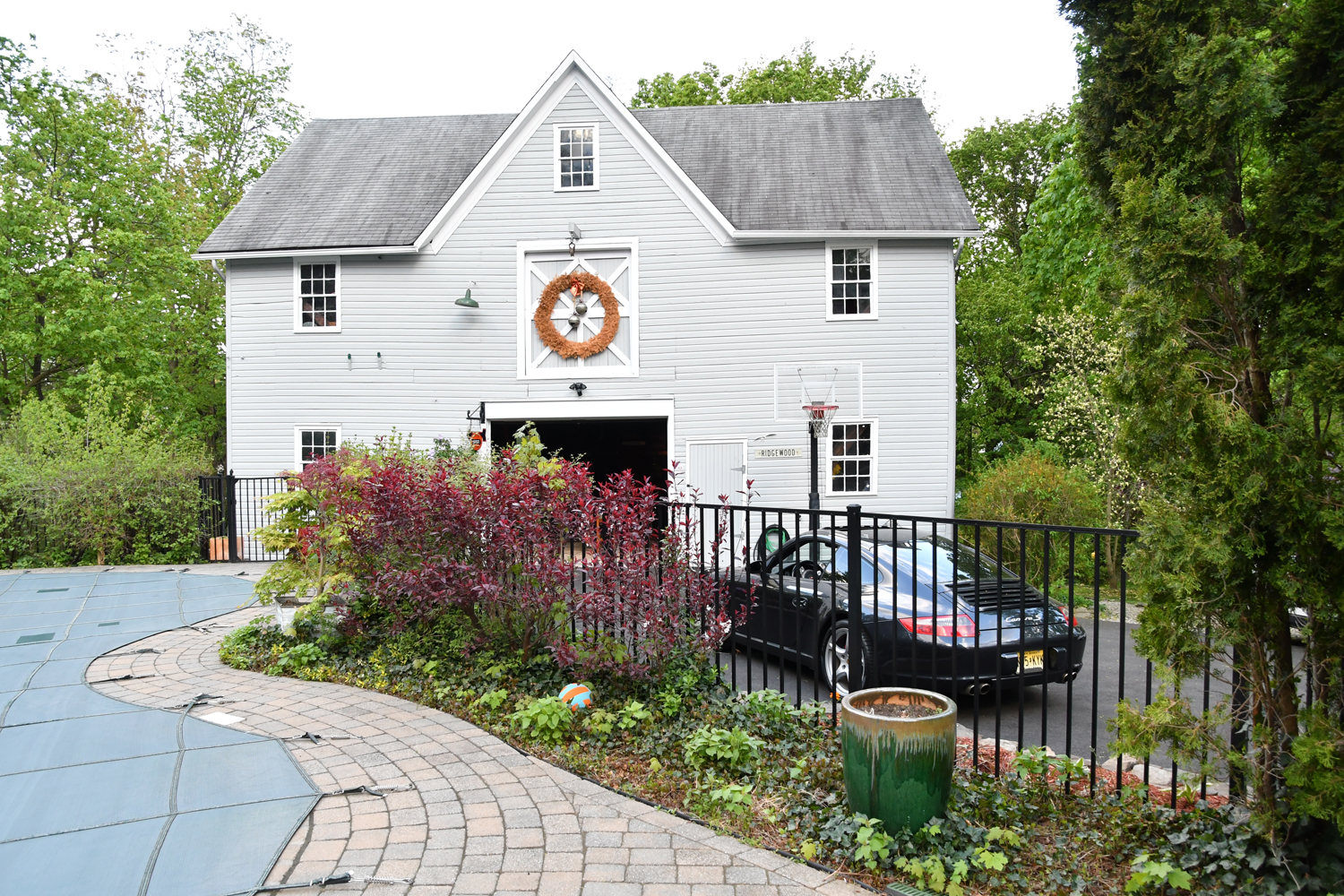
Born and raised in Sydney Australia, Carl Grady emigrated to the United States right after 9/11. Always a car guy even as a young boy, Carl says, “On family rides in the countryside outside of Sydney, I’d be sitting in the back of the family sedan. I’d look out at the farms and the garages and barns and hope I’d get a sneak peek of something. You know, something sitting out there waiting to be discovered. I loved doing that.”
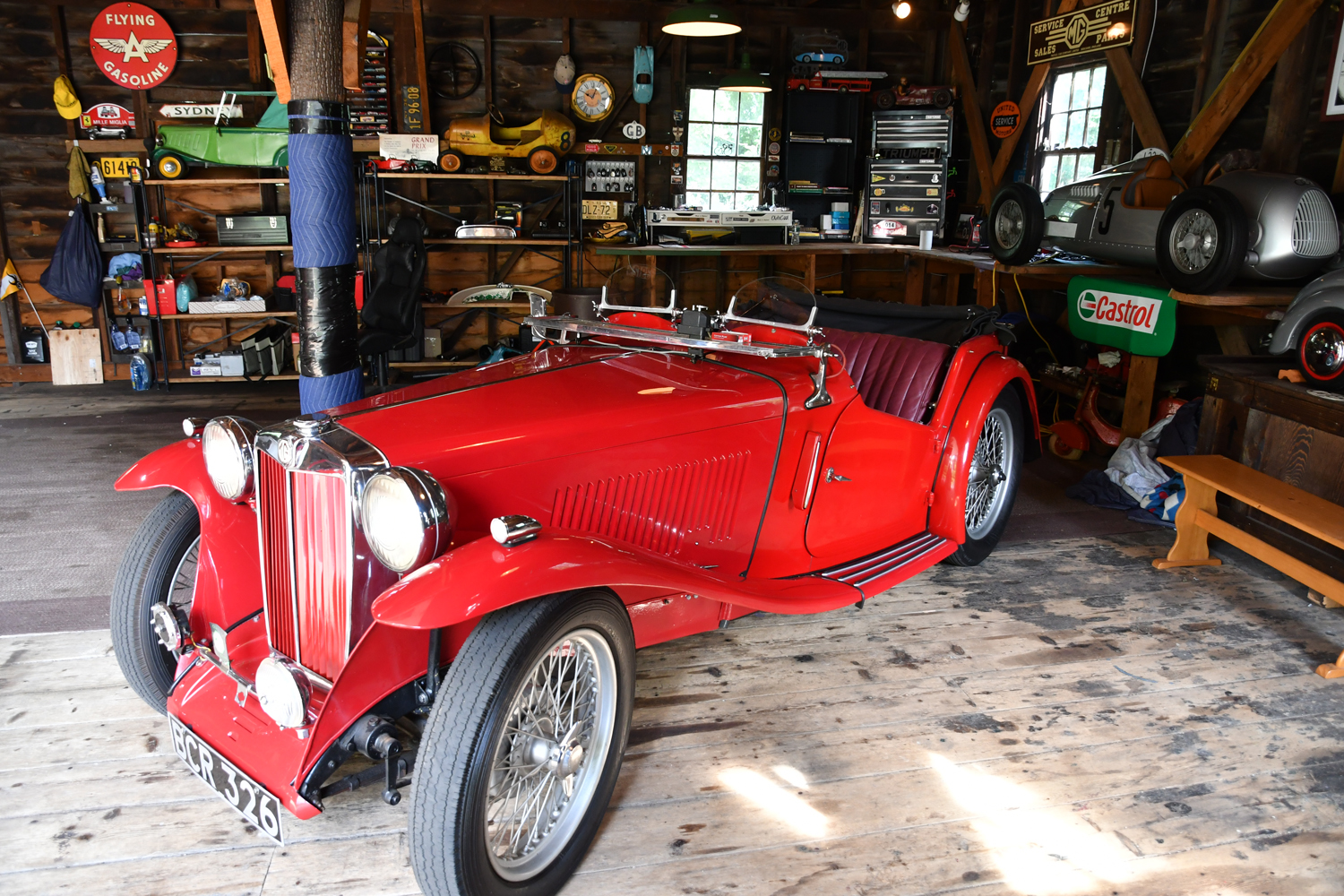
1937 MGTA
Once in America, Carl enjoyed and took advantage of vintage car prices considerably more reasonable than those for comparable British and American cars in Australia. As a result he began to build a collection. However as all Car Guys know, when building s collection, space is the final frontier.
Carl’s “barn” find did not demand a long journey to the back country. Carl actually had a home in walking distance from where he found the barn three years ago. He says, “At the time I had a few cars. Unfortunately, I only had a single-car garage.” This resulted in his eclectic collection of American and British vehicles being strewn about the grounds of his home. He had cars parked in the driveway and around and about under covers. Then, Carl says, “We had a pretty bad winter. I knew I had to do something about protecting them.”
In the midst of a Google search for available garage space, a reference to a house with a four-car garage close to his home popped up. He laced up his sneakers and strolled from his home to take a look.
Hidden away behind the home being sold stood a 3 1/2-story barn built into sloping property with vehicle access on two levels. Carl says, “I told my kids to meet me for a look.” He did not even look at the house. When his kids got there he simply told them “We are moving.” Carl says, “It was just too good to pass up.”
Built in 1902, the barn served as a kind of parking garage for the horses and carriages that transported people around the town of Ridgewood, NJ when they came by train from New York to visit.

Model A and TR3
The barn’s second floor that opens to the driveway actually served as the main level providing the area where the wagons would be parked. The gravel path leading down and around brought the horses to stables on the first level in the rear.
Carl says, “It’s still pretty much the original barn. You can see the tree trunks that hold it up. I’ve tried to keep it as rustic as possible. If you go downstairs, you’ll even see some of the horse stalls and some of the original harness paraphernalia.” In fact a buggy that was built in 1902 is still on the ground floor in its original unrestored condition.” Until Carl the barn had never housed a vehicle.
As all Car Guys know, there is no such thing as an empty garage bay, its more accurate description is that of a place holder for the vehicle yet to be purchased. In Carl’s case his spacious barn quickly filled. With the recent sale of his 1960 MGA fixed head coupe and TR6 and the addition of a 1930 Ford Model A coupe and 1948 Austin 840 Devon Sedan his collection consists, together with the Model A and Austin, of a 1937 MGTA, 1960 Triumph TR3, 1960 Triumph Herald Coupe, 1960 MGA roadster and a 1963 Ford Thunderbird.
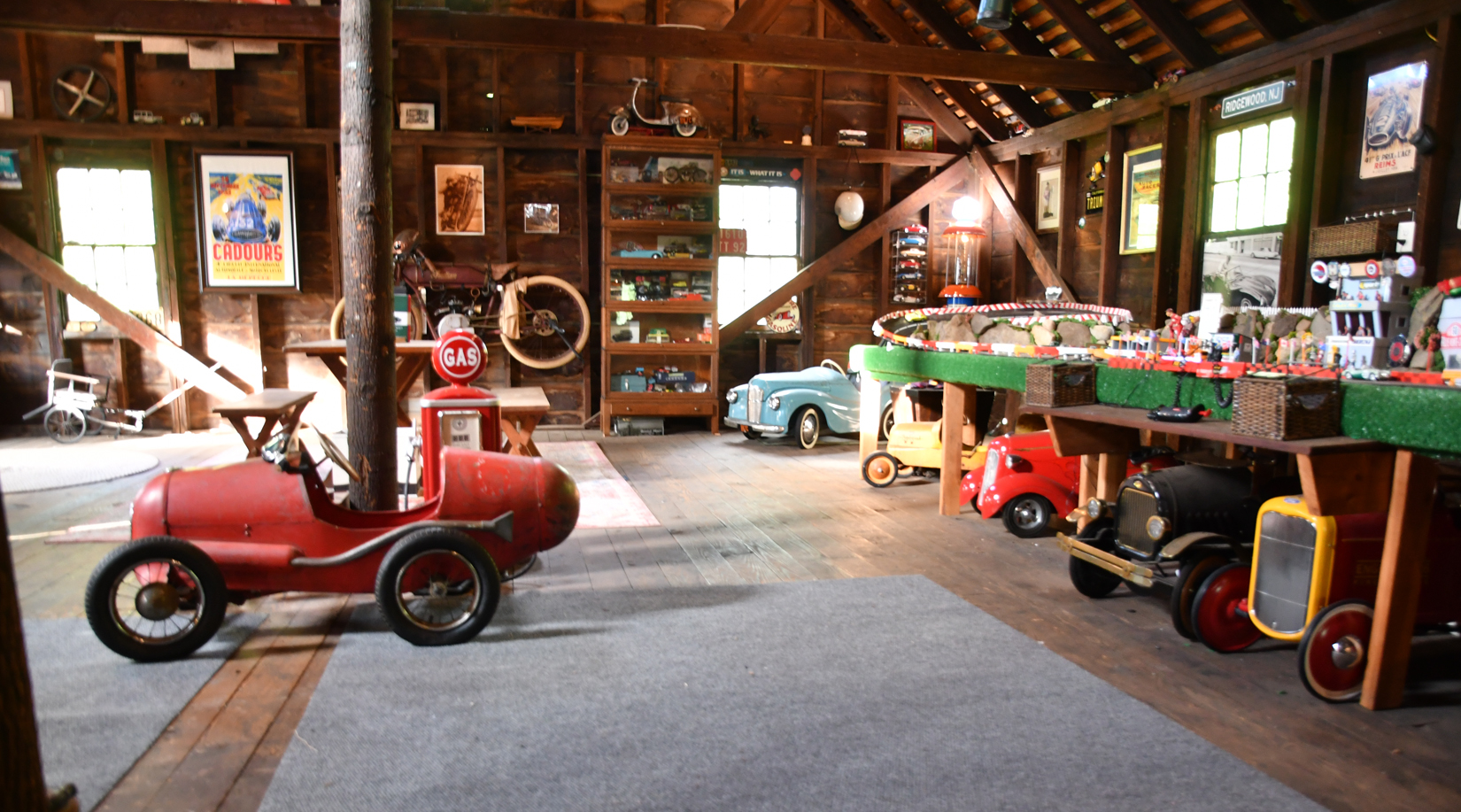
Carl admits his passion resides with American and English makes based on his youthful exposure in Australia where English makes provided the majority of road traffic with American models enjoying the stature of almost an exotic. His passion for Anglo Saxon brands accompanies an equal passion for using the cars in his collection as they were intended and that means his cars are driven. Carl says, “While I view them all as pieces of art, I believe their beauty stands out best when in motion.” For Carl the best part of car shows comes with driving to them and back home. He says, “I’m not interested in concours shows that demand hours of cleaning. It’s just not my deal, I don’t care necessarily about a hundred point car. I just like a car to look neat and original without getting too carried away.” He feels his blue 1960 MGA roadster displays his philosophy perfectly. Like battle scars, the nicks and dings acquired through spirited driving on real roads enhance the spunky blue MGA’s well earned patina.
When asked about his favorite ride, Carl falters a bit in committing saying, “The MGA roadster was my favorite, but now it competes for attention with the MGTA and the TR3. Last summer, I drove the TR3 more than any of the other cars.”
Carl says, “I have always liked the MGA. It has the MGB engine in it. It goes. It moves. It’s just noisy. It has a 4-speed and is just a lot of fun to blast around. Carl with a self-deprecating smirk goes on to say, “It’s broken down so many times on the road, but hey that too represents a signature quality of the British sports cars motoring experience.”

TR3 and MGA
Carl’s affection for the TR3 begins with the cut down doors and the feeling that it delivers a more relaxing and less intense driving experience than the noisy MGA. Comparing the two, Carl says, “The TR3 is just as enjoyable but instead of delivering the intensity of a sprint, the TR3 delivers the more relaxing experience of a long leasurely run.”
In speaking about the 1937 MGTA Carl says, “Just the novelty of driving a pre-war vehicle in itself is cool. Plus it’s right-hand drive. It’s a beautiful car. Granted, you don’t drive fast, but with the windscreen and windows all down the driving experience transports you with a stirring time behind the wheel of a time machine. It really delivers a cool nostalgic drive.”
Again demonstrating the powerful draw presented by open and readily fillable space, Carl’s barn features an extraordinary array of pedal cars and automobilia.
While always attracted to pedal cars Carl never thought about collecting them. However, under the constant urging of his friend Buz Korn, a skilled and dedicated collector of all things automotive, Carl took the plunge. After buying a French pedal car that had caught his eye, Carl’s pedal car pursuits were off and running. As Carl says, “I just started to look and then got a little crazy.” Two of his favorite pedal cars are an Austin J40 and an Auto Union Type C pre-war Silver Arrow Grand Prix.
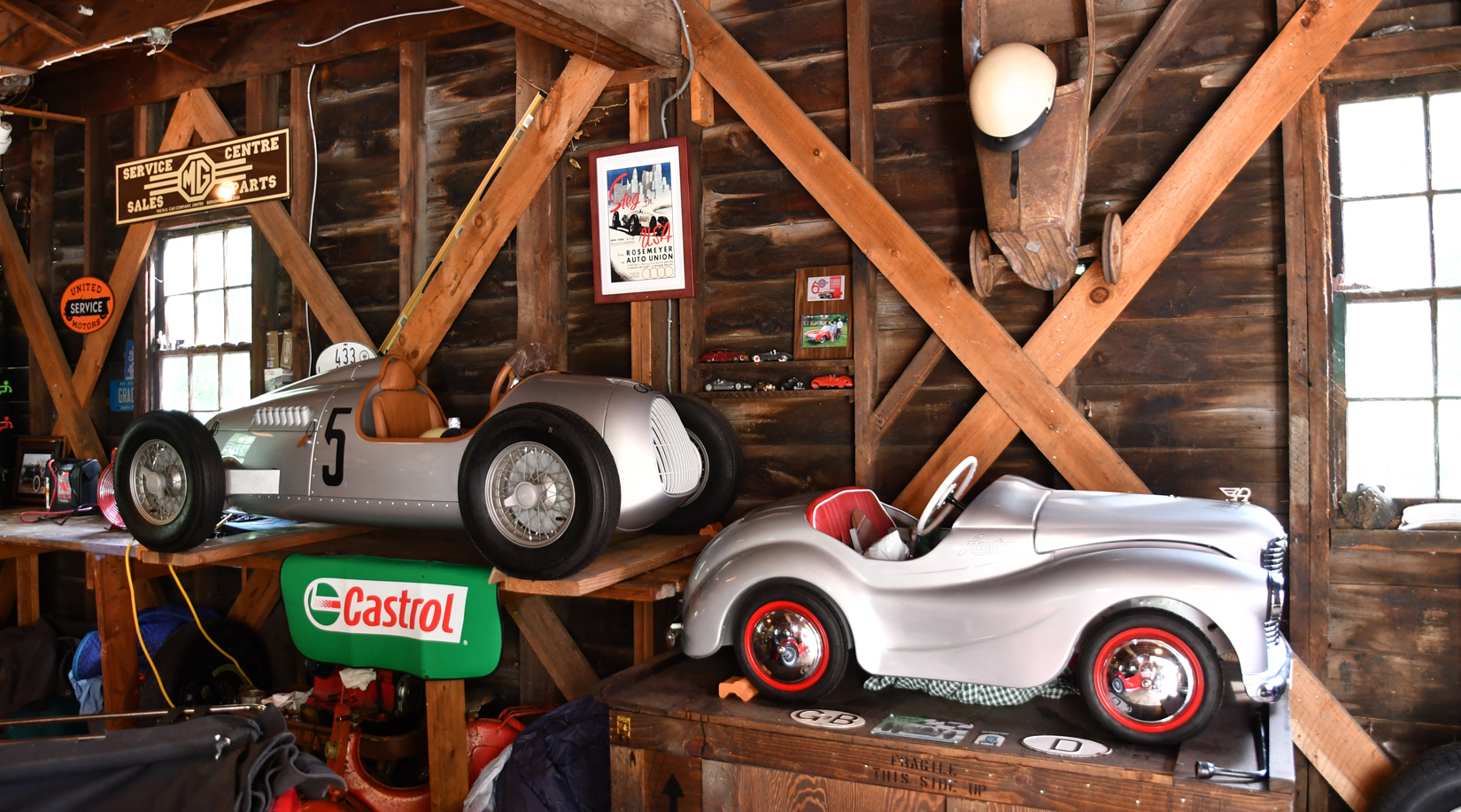
Auto Union and J40 Pedal Cars
Like it drove out of “Who Framed Roger Rabbit” its curvy voluptuous body style makes the J40 a kid and collector favorite. Carl says, “There is an event every year at Brooklands. The kids run to the cars, jump in and race down the track to win a prize.”
The original concept for the pedal came as an act of the British Parliament in 1943. The act recognized that coal miners were being struck down with the black lung disease. The plan for providing work for these stricken miners was to have them build a toy pedal car based on the Austin Devon and made from the scrap metal left over from the production line. Production ran from 1950 to 1971 with 32,098 models being produced.
Carls’s Auto Union Grand Prix pedal car plays to his strong interest in the Grand Prix cars of the pre-WWII era.
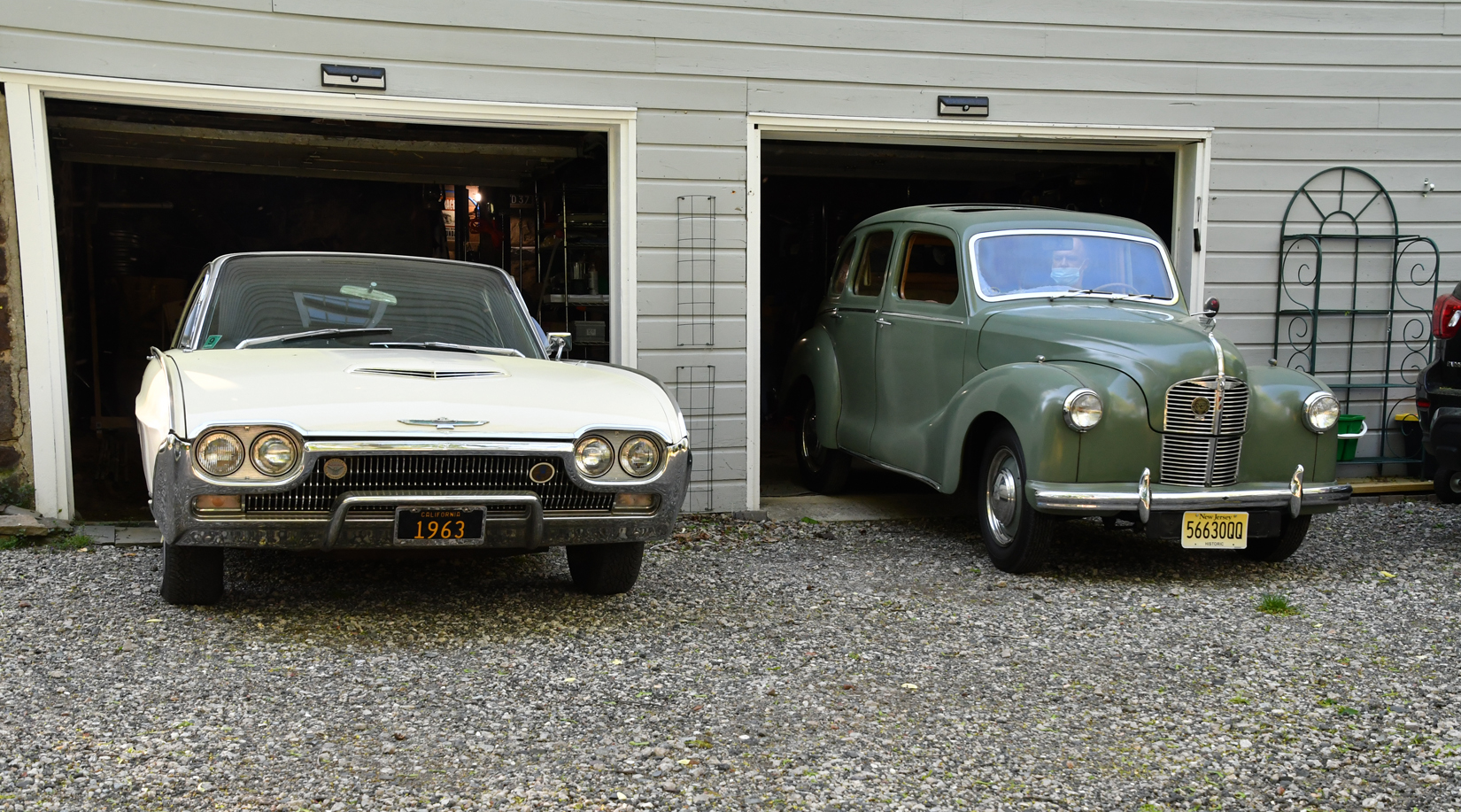
1963 Thunderbird and Austin 840
Commissioned by Audi in 2007 as a promotional item with a limited run of 999, it provides full racing bicycle mechanics and rear wheel drive gearing. Anyone who can fit in it can pedal it.
On a far more altruistic plane, Carl envisions his barn offering the opportunity to gather far more than interesting vehicles, he sees it as a meeting place to foster camaraderie among people of like interests. Carl says, “I would love for the barn to serve as a welcoming venue to promote the gathering of car enthusiasts.” He would have it become a casual arena for the sharing of stories, information and friendship.
As we come out of the age of Covid, Carl’s vision offers a wonderful inspiration to escape the no longer forced isolation.

Carl is one of the best promoters of British cars that I have ever met. Not only is he very knowledgeable and passionate about them, but his Australian accent makes everything he says even more authentic! He is a warm and wonderful guy who has a collection that any car guy would be very proud of! Burton, great piece of story telling! Hope to see both of you guys at an outside, socially distanced, safe and fun car event in the not too distant future.
Carl is a great guy. I really hope we can pull the gathering concept together.
Love the Auto Union pedal car. Barns are cool.
It is very cool and very well done. Just like the barn.
Amazing!
A wonderful structure living a beautiful second life.
Thank you Burton for giving me the opportunity to share my long term passion……………always looking for the next “piece ” i hope the readers enjoy the article and inspired to follow their passion ..as I get older my mantra is simple ..”if not now ..when ? “” Just do it!!
Thank you for sharing your special place and great story. Much appreciated.
I love the barn and that it is still very original
It truly is special.